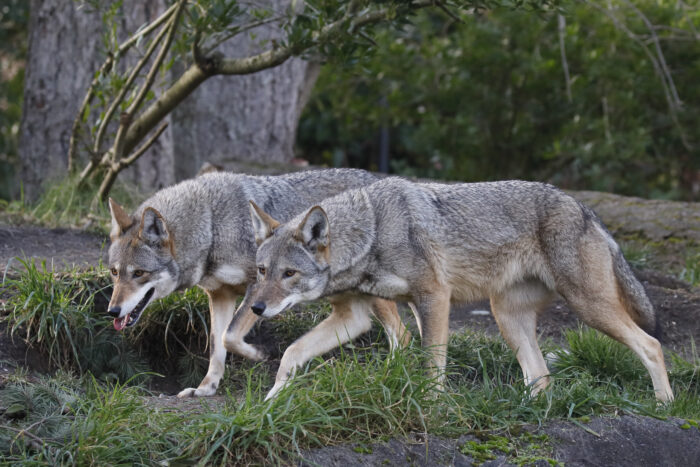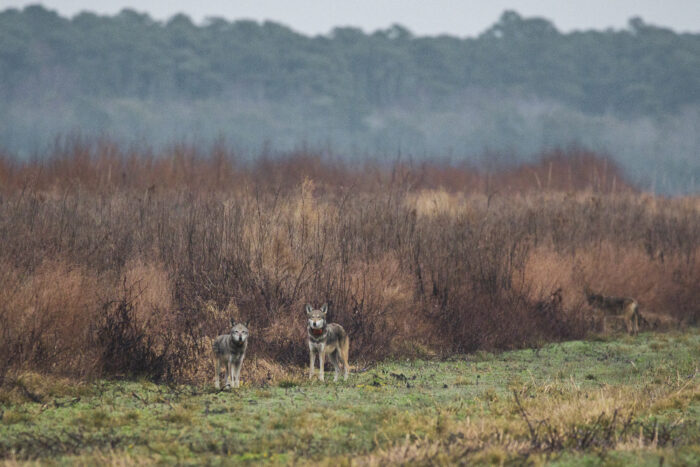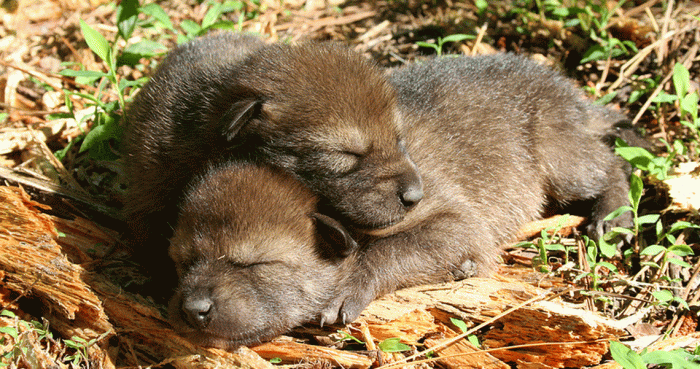Historic settlement secures conservation of endangered red wolves in the wild
There is new hope for the critically endangered red wolf.
In recent years, after the U.S. Fish and Wildlife Service abandoned its successful conservation efforts, the number of known wild red wolves had dropped to as low as seven. SELC just secured a historic settlement requiring USFWS to resume their red wolf conservation efforts and bring this majestic animal back from the brink of extinction during a time of alarming biodiversity loss.
We hope to see America’s wild red wolves rebound again, with generations born free and wild, as a result of this agreement.
Ramona McGee, SELC’s Wildlife Program Leader
Our latest agreement, filed with the U.S. District Court for the Eastern District of North Carolina, resolves our 2020 lawsuit on behalf of the Red Wolf Coalition, Defenders of Wildlife, and the Animal Welfare Institute.
“For 25 years, North Carolina was home to one of the most successful predator reintroductions in the world. This settlement puts us on a path to restoring the red wolf to its rightful place as a celebrated success story,” said Ramona McGee, senior attorney and leader of SELC’s Wildlife Program. “We hope to see America’s wild red wolves rebound again, with generations born free and wild, as a result of this agreement.”

The agreement requires the agency to recommit to the conservation of these rare wolves in the wild by developing annual plans to release captive red wolves and providing annual briefings regarding coyote management efforts for a period of eight years. The plans will be developed in consultation with the agency’s scientists and experts in the field and include metrics to measure the agency’s performance.
The USFWS “acknowledges the importance of the Eastern North Carolina red wolf population to red wolf conservation and recovery,” according to the agreement, which states the agency’s intentions to continue to implement adaptive management strategies, prepare captive wolves for release, reduce human-caused mortality, and engage with community members and stakeholders.
“This settlement marks a new era for the Red Wolf Recovery Program and guarantees action in the near-term to give this species the best chance for long-term survival and recovery,” said Ben Prater, Southeast program director at Defenders of Wildlife. “We now have a durable solution and an enduring commitment to wild red wolf conservation.”
Prater added that the mechanisms established here will support a thriving wild population in North Carolina while reinforcing a science-based approach.

When the USFWS previously reintroduced red wolves into eastern North Carolina from captive populations and implemented adaptive coyote management to reduce hybridization, wild red wolves rebounded from extinction in 1987 to about 100 animals in the early 2000s. That population level persisted for approximately a decade.
But in 2015, the USFWS suspended its longstanding and successful practice of releasing captive red wolves into the wild within the approximately 1.7 million-acre Red Wolf Recovery Area in eastern North Carolina. The agency failed to resume the practice and instead later adopted a policy preventing releases of captive red wolves into the wild.
When the 2020 lawsuit was filed, as few as seven red wolves remained in the wild. Between 2019 and 2021, no red wolf pups were born in the wild for the first time in the program’s history, an indication of the dire state of the red wolf population at that time.
This agreement pulls wild red wolves back from the brink of extinction. It signals a return to the management approach that was hailed as a model for reintroduction efforts and served the red wolf so well for nearly 30 years.
Johanna Hamburger, Animal Welfare Institute
The lawsuit SELC filed against the USFWS in November 2020 addressed violations of the Endangered Species Act caused by illegal agency policies that barred the use of proven management measures to save wild red wolves. The groups also filed a motion for a preliminary injunction in the case, seeking to block the agency’s policy of prohibiting the release of captive wolves into the wild. That motion was granted on January 22, 2021.
“When we filed this lawsuit, scientists warned that if the USFWS continued down that path, red wolves could be extinct in the wild by 2024,” said Johanna Hamburger, director and senior attorney for the Animal Welfare Institute’s terrestrial wildlife program. “This agreement pulls wild red wolves back from the brink of extinction. It signals a return to the management approach that was hailed as a model for reintroduction efforts and served the red wolf so well for nearly 30 years.”

Under a 2021 court order in this case, the USFWS in 2021, 2022, and 2023 released captive red wolves into the wild population, including by placing captive-born pups in wild litters. The federal court directed the agency to develop a plan for the release of captive-born red wolves into the wild in North Carolina. Such releases had been consistent practice of the agency from 1987 to 2014.
Following these releases, reproduction in the wild resumed, with wolves giving birth to and raising litters of pups in the wild in 2022 and 2023.
“This latest settlement agreement lays out a road map, along with other management actions by the USFWS, for the survival of red wolves in the wild,” said Kim Wheeler, executive director of Red Wolf Coalition. “It will take continued hard work and collaborative efforts, by all stakeholders, to build a solid foundation that will see red wolf restoration well into the future. The Red Wolf Coalition sees this settlement agreement as one of the building blocks of that strong foundation.”
SELC is working to protect the world’s only wild red wolf population.
